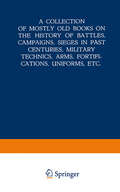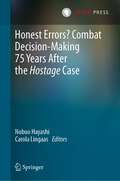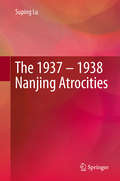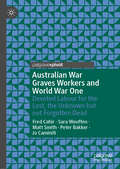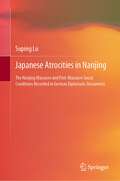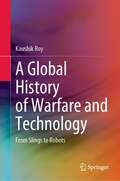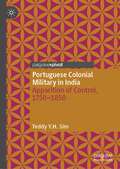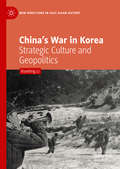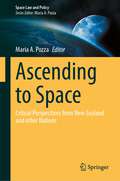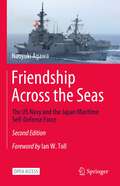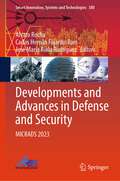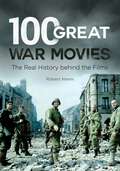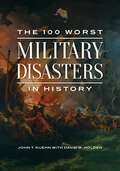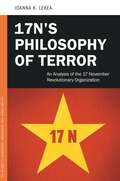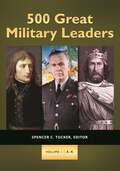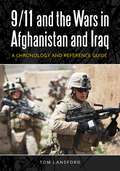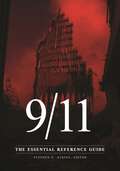- Table View
- List View
The Girls in Green: Soon to be a major web series
by Tanushree PodderFour girls. One uniform. One dream. Set in the Officers' Training Academy, this is the storyOf Bijli Bijarnia aka Billi, the girl with feline grace and lightning-fast ref lexes, determined to tear through thesocial taboos of Haryana hinterland from where she hails.Of Lakmenlang Zyiem aka Lakme from Shillong, the optimistic law graduate who is the first Khasi girl to join the academy.Of Shiny Joseph from Kottayam, who only joins the academy to be near her boyfriend but finds herself pitted against him more often than not.Of Nutan Patil aka Nutty from Jalna, the mimic, the incurable romantic, the effervescent drama queen. The Girls in Green is a story not only about soaring ambition and punishing military regimens, but also about gratifying rewards and the joys of friendship.
The Indian Contingent: The Forgotten Muslim Soldiers Of Dunkirk
by Ghee Bowman‘An important and essential work’ SATHNAM SANGHERA‘An incredible and important story’ MISHAL HUSAIN‘Groundbreaking ... a riveting and moving account’ YASMIN KHAN‘A fitting recognition of the contribution of Dunkirk’s forgotten soldiers’ ANAS SARWAROn 28 May 1940, in the early days of the Second World War, Major Akbar Khan marched at the head of 299 soldiers along a beach in northern France. They were the only Indians in the British Expeditionary Force at Dunkirk. With Stuka sirens wailing, shells falling in the water and Tommies lining up to be evacuated, these soldiers of the British Indian Army, carrying their disabled imam, found their way to the East Mole and embarked for England in the dead of night. On reaching Dover, they borrowed brass trays and started playing Punjabi folk music, upon which even ‘many British spectators joined in the dance’. What journey had brought these men to Europe? What became of them and their comrades captured by the Germans? With the engaging style of a true storyteller, Ghee Bowman reveals for the first time the astonishing story of the Indian contingent – the Muslim soldiers who fought in the pivotal Battle of Dunkirk – from their arrival in France on 26 December 1939 to their return to an India on the verge of Partition.
A Bird from Afar: A Novel
by Anshul Chaturvedi‘Chaturvedi goes beyond the admiration and the controversy to chase down the mystique of the man Bose was ... A compelling read’ Pritish Nandy‘Combines a sure grasp of history with an ability to convert little-known facts into a marvellous fictional page-turner’ Mihir BoseNazi Germany, 1942.Stalingrad has fallen to the Axis powers after a bitter, brutal campaign; in North Africa, Field Marshal Rommel’s Afrika Korps has emerged victorious; Rangoon has been seized by the Japanese after their capture of Singapore. Amidst these developments, Indian nationalist leader Subhas Chandra Bose has been camped in wartime Berlin, since 1941, working furiously to build an army that will be able to march with him overland towards the Indian frontier. Bose is confronted with multiple dilemmas: in order to free India militarily from the clutches of the British empire, he must ally with Hitler’s forces, the Japanese army and Mussolini’s troops. And even if he succeeds, can a post-British India emerge as a single, united country? Set during a turbulent and complex time in our nation’s history, A Bird from Afar is an unforgettable tale of courage, resilience and Subhas Bose’s obsessive quest for Indian independence during the Second World War.
Kashmir at the Crossroads: Inside a 21st-Century Conflict
by Sumantra Bose[Written] with admirable clarity' Literary Review'Excellent . . . concise and chilling' IndependentAn authoritative, fresh, and vividly written account of the Kashmir conflict?from 1947 to the present.The India-Pakistan dispute over Kashmir is one of the world’s incendiary conflicts. Since 1990, at least 60,000 people have been killed?insurgents, civilians, and military and police personnel. In 2019, the conflict entered a dangerous new phase. India’s Hindu nationalist government, under Narendra Modi, repealed Indian-administered Jammu and Kashmir’s autonomous status and divided it into two territories subject to New Delhi’s direct rule. The drastic move was accompanied by mass arrests and lengthy suspension of mobile and internet services.In this definitive account, Sumantra Bose examines the conflict in Kashmir from its origins to the present volatile juncture. He explores the global context of the current situation, including China’s growing role, as well as the human tragedy of the people caught in the bitter dispute. Drawing on three decades of field experience in Kashmir, Bose asks whether a compromise settlement is still possible given the ascendancy of Hindu nationalism in India and the complex geopolitical context.
The Shortest History of War
by Gwynne Dyer‘An incisive and well-informed overview of how warfare has evolved’ PUBLISHERS WEEKLY‘From the first armies to clashes of drones and dirty bombs, this is eye-opening, big-picture stuff’ BBC HISTORY‘Readable and sharp ... does what it says on the tin’ INDEPENDENT‘Dyer writes with eloquence and authority’ IRISH EXAMINERWar has changed, but we have not. From our hunter-gatherer ancestors to the rival nuclear powers of today, whenever resources have been contested, we’ve gone to battle. In this brisk and gripping account, acclaimed military historian Gwynne Dyer traces the evolution of martial clashes, tracing warfare from prehistory to the world’s first cities and on to the thousand-year ‘classical age’ of combat, which ended when the firearm changed everything.Dyer explores the shift from limited to total war, interrupted by Hiroshima’s nuclear impact, until the Cold War and Russia’s invasion of Ukraine ended the longest peace among major powers since the World War II. Now as climate change intensifies resource competition, superpowers fill up their arsenals with atomic bombs, drones and futuristic weapons of mass destruction.All through, Dyer delves into anthropology, psychology and other relevant fields to unmask the drivers of conflict, making The Shortest History of War a book for anyone who wants to understand the role of war in the human story – and how we can prevent it from defining our future.
A Collection of Mostly Old Books on the History of Battles, Campaigns, Sieges in Past Centuries, Military Technics, Arms, Fortifications, Uniforms, Etc.
by Martinus NijhoffPerspectives on Military Intelligence from the First World War to Mali: Between Learning and Law
by Floribert Baudet Eleni Braat Jeoffrey Van Woensel Aad WeverMany intelligence practitioners feel that the statutory footing on which intelligenceagencies have been placed forms an impediment to confronting unprecedented contemporarychallenges. On the basis of case studies spanning the period from the First WorldWar to the present, this book argues that while the intelligence community in the era ofglobalization has indeed come to face new and complex challenges that require adaptation,operating in demanding and changing environments is not new at all. This book questionsthe conventional wisdom of 9/11 or the end of the Cold War as caesurae. It also argues thatthe ability to adapt, innovate, question and learn from past experience is crucial for thesuccess of intelligence organizations, rather than ever-expanding funding.Agencies’ ability to reflect, adapt and learn from experience determines their subsequentcapability to deliver. One key development resulting from globalization is the markedincrease in cooperation between intelligence agencies of different countries on the onehand, and between investigative agencies and intelligence agencies on the other. This hasled to concerns over human rights and privacy and to increased calls for accountability andimproved oversight as the increase in cooperation between organizations operating globallyalso provides scope for the circumvention of domestic restrictions.This book proposes an instrument to assess the effectiveness of existing accountabilityarrangements and offers new insights into the role of (military) intelligence in anumber of crises, e.g., the 1962 Cold War confrontation over Western New Guinea, and thefunctioning of intelligence in peacekeeping operations ranging from Srebrenica to Mali.Thematically comprehensive, it offers a mixture of historical, legal, operational, and policyaspects, analyzed through the lens of institutional learning, bringing together academic andpractitioners’ perspectives. The focus lies not only on the familiar Anglo-Saxon experiencebut also on cases from India, the Netherlands, South East Asia, Bosnia, Lebanon, and Mali.The book is aimed at both scholars and practitioners studying and/or working in the fieldof civil and military intelligence, and those involved in international relations and internationalhumanitarian law/human rights law. It brings together contributions from authorswho spoke at the Conference to commemorate the 100th anniversary of the Dutch MilitaryIntelligence and Security Service, organized by the Netherlands Intelligence Studies Association(NISA), and from a number of authors who were specifically invited to participate.
Honest Errors? Combat Decision-Making 75 Years After the Hostage Case
by Nobuo Hayashi Carola LingaasThis book marks the 75th anniversary of the 1948 Hostage Case in which a US military tribunal in Nuremberg acquitted General Lothar Rendulic of devastating Northern Norway on account of his honest factual error. The volume critically reappraises the law and facts underlying his trial, the no second-guessing rule in customary international humanitarian law (IHL) that is named after the general himself, and the assessment of modern battlefield decisions.Using recently discovered documents, this volume casts major doubts on Rendulic’s claim that he considered the region’s total devastation and the forcible evacuation of all of its inhabitants imperatively demanded by military necessity at the time. This book’s analysis of court records reveals how the tribunal failed to examine relevant facts or explain the Rendulic Rule’s legal origin. This anthology shows that, despite the Hostage Case’s ambiguity and occasional suggestions to the contrary, objective reasonableness forms part of the reasonable commander test under IHL and the mistake of fact defence under international criminal law (ICL) to which the rule has given rise. This collection also identifies modern warfare’s characteristics—human judgment, de-empathetic battlespace, and institutional bias—that may make it problematic to deem some errors both honest and reasonable. The Rendulic Rule embodies an otherwise firmly established admonition against judging contentious battlefield decisions with hindsight. Nevertheless, it was born of a factually ill-suited case and continues to raise significant legal as well as ethical challenges today.The most comprehensive study of the Rendulic Rule ever to appear in English, this multi-disciplinary anthology will appeal to researchers and practitioners of IHL and ICL, as well as military historians and military ethicists and offers ground-breaking new research.Nobuo Hayashi is affiliated to the Centre for International and Operational Law at the Swedish Defence University in Stockholm, Sweden.Carola Lingaas is affiliated to the Faculty of Social Studies at VID Specialized University in Oslo, Norway.
The Maritime Defence of China: Ming General Qi Jiguang and Beyond
by Y.H. Teddy SimThis edited volume explores the larger maritime and security environment during and beyond the time of Chinese military general Qi Jiguang’s enterprise. While serving as a historiography and biography of Qi Jiguang, the book also elaborates on the doctrinal applications of his ideas. Essays in this volume contribute to the field of China studies in light of the increased frequency of news relating to the maritime and military affairs in the region in the post-2000 period. It provides a specialist perspective to the uneven study of Qi Jiguang and maritime/military studies, while also satisfying the desire of the layman to understand the current political security situation in East Asia in the context of the longer term historical developments.
The 1937 – 1938 Nanjing Atrocities
by Suping LuThis book presents a comprehensive overview of the Nanjing Massacre, together with an in-depth analysis of various aspects of the event and related issues. Drawing on original source materials collected from various national archives, national libraries, church historical society archives, and university libraries in China, Japan, Germany, United Kingdom and the United States, it represents the first English-language academic attempt to analyze the Nanjing Massacre in such detail and scope.The book examines massacres and other killings, in addition to other war crimes, such as rape, looting, and burning. These atrocities are then explored further via a historical analysis of Chinese survivors’ testimony, Japanese soldiers’ diaries, Westerners’ eyewitness accounts, the news coverage from American and British correspondents, and American, British and German diplomatic dispatches. Further, the book explores issues such as the role and function of the International Committee for Nanking Safety Zone, burial records of massacre victims, post-war military tribunals, controversies over the Nanjing Massacre, and the 100-Man Killing Contest.This book is intended for all researchers, scholars, graduate and undergraduate students, and members of the general public who are interested in Second World War issues, Sino-Japanese conflicts, Sino-Japan relations, war crimes, atrocity and holocaust studies, military tribunals for war crimes, Japanese atrocities in China, and the Nanjing Massacre.
Australian War Graves Workers and World War One: Devoted Labour for the Lost, the Unknown but not Forgotten Dead
by Fred Cahir Sara Weuffen Matt Smith Peter Bakker Jo CaminitiThis book relays the largely untold story of the approximately 1,100 Australian war graves workers whose job it was to locate, identify exhume and rebury the thousands of Australian soldiers who died in Europe during the First World War. It tells the story of the men of the Australian Graves Detachment and the Australian Graves Service who worked in the period 1919 to 1922 to ensure that grieving families in Australia had a physical grave which they could mourn the loss of their loved ones. By presenting biographical vignettes of eight men who undertook this work, the book examines the mechanics of the commemoration of the Great War and extends our understanding of the individual toll this onerous task took on the workers themselves.
Image, Imagination and Imaginarium: Remapping World War II Monuments in Greater China
by Lu PanThis book explores five cases of monument and public commemorative space related to World War II (WWII) in contemporary China (Mainland), Hong Kong and Taiwan, all of which were built either prior to or right after the end of the War and their physical existence still remains. Through the study on the monuments, the project illustrates past and ongoing controversies and contestations over Chinese nation, sovereignty, modernism and identity. Despite their historical affinities, the three societies in question, namely, Mainland China, Hong Kong and Taiwan, vary in their own ways of telling, remembering and forgetting WWII. These divergences are not only rooted in their different political circumstances and social experiences, but also in their current competitions, confrontations and integrations. This book will be of great interest to historians, sinologists and analysts of new Asian nationalism.
Japanese Atrocities in Nanjing: The Nanjing Massacre and Post-Massacre Social Conditions Recorded in German Diplomatic Documents
by Suping LuThis book presents a collection of annotated English translations of German diplomatic documents—including telegrams, dispatches and reports—sent to the Foreign Office in Berlin and the German Ambassador in Hankou, China, by German diplomatic officials in Nanjing, and detailing Japanese atrocities and the conditions in and around Nanjing during the early months of 1938. The author visited the German Federal Archives (Bundesarchiv) and the German Foreign Ministry Archives (Auswärtiges Amt Archiv) in Berlin, where these documents are currently archived, in 2008, 2016, and 2017 to locate and retrieve them. These diplomatic documents are of significant value in that they provide both detailed information and wide coverage, from different locations and on various topics. Further, the information offered is unique in a number of ways. First, the events were recorded from the perspective of Germans, citizens of a country that was a close ally of Japan, and second, these documents are not included in any other source. As such, these archival primary sources represent an invaluable addition to the research literature on the Nanjing Massacre and will undoubtedly benefit researchers and scholars for generations to come.
A Global History of Warfare and Technology: From Slings to Robots
by Kaushik RoyThis book addresses the global history of technology, warfare and state formation from the Stone Age to the Information Age. Using a combination of top-down and bottom-up methodologies, it examines both interstate and intrastate conflicts with a focus on Eurasian technology and warfare. It shows how human agency and structural factors have intertwined, creating a complex web of technology and warfare. It also explores the interplay between technological and non-technological factors to chart the evolution of warfare from its origins to the present day, arguing that the interactions between civilian and military sectors have shaped the use of technology in warfare. Given its scope and depth, it is a valuable resource for researchers in fields such as world history, history of science and technology, history of warfare and imperialism and international relations.
Portuguese Colonial Military in India: Apparition of Control, 1750--1850
by Teddy Y.H. SimThis book explores and analyzes developments in the military institution, military engagements as well as the larger security environment of (including non-war violence and maritime regions linking to) the Portuguese Empire in India. These developments occurred under the onslaught of the early modern globalization. The research shows that far from being dilapidated or archaic, the Portuguese colonial military there kept up with some developments in technology and organization in a competitive environment. Although the colonial military was not the most important reason in accounting for the survival of the Portuguese Estado da Índia, nor was the military profession the most lucrative occupation, the Portuguese experience gave indication of how a colonial state and society was able to survive against coalescing threats from the position of weakness. Located in the period and geographical region of the wax and waning of the Mughal and Maratha empires, Portuguese India was not necessarily a more violent place than the surrounding territories although resistance to and uprising against the Portuguese was usually underestimated. Beginning from the attempt at political and military centralization (and standardization) in the eighteenth century, the abolition of the army of the Estado da Índia in the nineteenth marked nominally the end of an era that may have a reverberation on the pacifist perception of Goa today.
China’s War in Korea: Strategic Culture and Geopolitics (New Directions in East Asian History)
by Xiaobing LiThis book re-visits the history of the Korean War of 1950-1953 from a Chinese perspective, examining Chinese strategy and exploring why China sent three million troops to Korea, in Mao’s words, to “defend the homeland and safeguard the country”—giving rise to what became the war’s common name in China. It also looks into the relatively neglected historical factors which have redefined China’s security concerns and strategic culture. Using newly available sources from China and the former Soviet Union, the book considers how interactive the parameters of defense changes were in a foreign war against Western powers, how flexible Chinese strategy was in the context of its intervention, and how expansive its strategic cultural repertoire was at the crucial moment to “defend the country.” Providing a re-examination of China’s military decisions and strategy evolution, this text narrates the story of successive generations of Chinese leaders and provides a key insight into security issues in China and Northeast Asia today.
Ascending to Space: Critical Perspectives from New Zealand and other Nations (Space Law and Policy)
by Maria A. PozzaThis book explores multidisciplinary perspectives on critical issues in space from the viewpoints of New Zealand and other nations. It brings together the topics examined at the Otago Foreign Policy School 2022 by both domestic and international experts in the area of space, and includes the opening address on space policy delivered by the Minister of Foreign Affairs. This book takes a multidisciplinary approach to New Zealand’s growing space sector in conjunction with other nations’ perspectives on space. It encompasses space science, military and defence matters, space tourism and astronaut rescue, and international legal and policy frameworks, while taking into account future considerations. Readers such as academics, students, policy advisers, diplomats, government officials and others engaged in the field of space will find value in this book. It will appeal to think tanks and international institutions grappling with the complexities that are presented by the outer space domain.
Friendship Across the Seas: The US Navy and the Japan Maritime Self-Defense Force
by Naoyuki AgawaThis Open Access book describes the history of the relationship between the Japan Maritime Self-Defense Force (JMSDF), the heir to the Imperial Japanese Navy (IJN), and the United States Navy (US Navy), with a focus on the individuals who helped build it. Former enemies who fought fiercely on the seas and in the air during the Pacific War, the two navies came to respect each other in action. Soon after the war, when the Cold War turned hot, they began to work together as allies, driven by their respective national interests. With the generous assistance of the US Navy, the JMSDF was established as its counterpart. Over the years, these two navies have gradually built strong ties. Individual officers and sailors on both sides overcame mixed feelings about their erstwhile foes to feel respect for and trust in each other. This was made possible by conducting countless joint exercises and operations at sea. US Navy leaders began to realize that this small maritime force, notwithstanding domestic political, constitutional, and legal limitations, does its job well, is reliable, and can be fully trusted. The JMSDF realized that, sharing common interests and values, there was no better navy in the Asia-Pacific region to ally with. Over seventy years of accumulated shared experiences have transformed this into perhaps the most successful navy-to-navy partnership in the world. The US-Japan maritime alliance today is anchored in this history. Numerous admirals, officers, and sailors of the two navies working together have greatly contributed to the stability and prosperity of the Asia-Pacific region for the past seven decades. This book is intended for readers interested in the history of US-Japan relations and for naval officers and sailors from the US and other countries. It is the author’s sincere desire that they read this book and appreciate the longstanding cooperation between the JMSDF and the US Navy.
Developments and Advances in Defense and Security: MICRADS 2023 (Smart Innovation, Systems and Technologies #380)
by Álvaro Rocha Carlos Hernán Fajardo-Toro José María Riola RodríguezThis book gathers the proceedings of the Multidisciplinary International Conference of Research Applied to Defense and Security (MICRADS 2023), held at Graduate School of the Colombian Air Force, in Bogota, Colombia, during July 6–8, 2023. It covers a broad range of topics in systems, communication, and defense; strategy and political–administrative vision in defense; and engineering and technologies applied to defense. Given its scope, it offers a valuable resource for practitioners, researchers, and students alike.
100 Great War Movies: The Real History behind the Films
by Robert J. NiemiThis book serves as a fascinating guide to 100 war films from 1930 to the present. Readers interested in war movies will learn surprising anecdotes about these films and will have all their questions about the films' historical accuracy answered.This cinematic guide to war movies spans 800 years in its analysis of films from those set in the 13th century Scottish Wars of Independence (Braveheart) to those taking place during the 21st-century war in Afghanistan (Lone Survivor). World War II has produced the largest number of war movies and continues to spawn recently released films such as Dunkirk. This book explores those, but also examines films set during such conflicts as the Napoleonic Wars, the American Civil War, World War I, the Vietnam War, and the wars in Afghanistan and Iraq.The book is organized alphabetically by film title, making it easy to navigate. Each entry is divided into five sections: Background (a brief discussion of the film's genesis and financing); Production (information about how, where, and when the film was shot); Synopsis (a detailed plot summary); Reception (how the film did in terms of box office, awards, and reviews) and "Reel History vs. Real History" (a brief analysis of the film's historical accuracy). This book is ideal for readers looking to get a vivid behind-the-scenes look at the greatest war movies ever made.
The 100 Worst Military Disasters in History
by John T. KuehnThe 100 Worst Military Disasters in History is a fascinating collection that educators, students, and historians will all find useful in helping them understand the causes and consequences of the most infamous military failures in history.The dynamics of military disaster are equally, if not more, important as understanding how to achieve success on the battlefield. This comprehensive book covers the complete gamut of human history as it tells the compelling stories of the worst military debacles of all time. It covers battles, campaigns, and wars, starting with the ancient Persians and Greeks and finishing with the U.S. conflicts in Afghanistan and Iraq. Not limited to land warfare, however, the book also includes a number of the most disastrous naval engagements and campaigns in world history.The 100 Worst Military Disasters in History opens with a detailed introduction illuminating the role military strategy and politics played in some of the worst battlefield failures throughout history. The entries are augmented with several engaging sidebars related to various military disasters. This eclectic collection includes coverage of many lesser known military disasters such as the Taiping Rebellion, during which 20 times more Chinese died than the number of people killed in the American Civil War.
17N's Philosophy of Terror: An Analysis of the 17 November Revolutionary Organization (PSI Guides to Terrorists, Insurgents, and Armed Groups)
by Ioanne K. LekeaThis book uses a cross-disciplinary approach to examine the creation, development, ideology, and practice of the Marxist terrorist group 17N.Were the members of 17N individuals with high moral principles, as they claimed, who did their best to protect the civilians who happened to be within their field of operations? Or were they simply violent guerillas who prioritized successful assassinations of their targets at any cost? The textual analysis of this book addresses these questions and studies 17N from inception to the time when its members were arrested, providing a uniquely thorough examination of the organization manifestos and its correlation to the group's ideology and actual practices.17N's Philosophy of Terror: An Analysis of the 17 November Revolutionary Organization first outlines the political and ideological framework of 17? and then describes their terrorist strategy and tactics. The authors consider these operations in the context of the manifestos that followed the terrorist acts, and conclude the work by addressing the events following the apprehension of 17N members—the trial, the verdicts, the appeal trial, and the conclusion of appeal trial.
500 Great Military Leaders [2 volumes]: [2 volumes]
by Spencer C. TuckerThis insightful encyclopedia examines the most influential commanders who have shaped military history and the course of world events from ancient times to the present.From Alexander the Great and Attila the Hun to Ho Chi Minh and Colin Powell, 500 Great Military Leaders provides readers with insight into the most innovative and prominent individuals who have led armies to victory on battlefields all over the world. The broad coverage ranges from military leaders from the ancient world to the present day, including political figures who directed war efforts and those who were responsible for major technological improvements. This encyclopedia goes beyond providing factual information about each individual's life to delve into the greater historical context and impact on their contemporaries as well as on future military history. The presentation of information is designed to enable readers to both observe the gradual evolution of warfare over time and clearly perceive the differences in tactics used by generals with varying military resources at their disposal.The entries include not only information on the individual's life and work but a summary statement that assesses successes and failures across each leader's career and summarizes the overall impact. Each entry also provides several references for further reading about that individual. The accessible writing style of this resource and in-depth information and analyses make it appropriate for high school and undergraduate-level students as well as scholars of military history and individuals who simply enjoy reading about military history.
9/11 and the Wars in Afghanistan and Iraq: A Chronology and Reference Guide
by Tom LansfordThis book analyzes the complex causes and effects of the September 11, 2001, terrorist attacks both domestically and internationally, and examines the subsequent wars in Afghanistan and Iraq.The first decade of the 21st century witnessed a watershed of political, economic, diplomatic, and military change as a direct result of the events of September 11, 2001. Through narrative chapters, a chronology of events, biographical sketches of principal players, and annotated primary documents, author Tom Lansford documents the domestic impact of the terrorist attacks that stunned the world as well as the subsequent "war on terror" and the invasions and occupations of Afghanistan and Iraq.9/11 and the Wars in Afghanistan and Iraq: A Chronology and Reference Guide explores the origins and aftermath of the September 11, 2001, terrorist attacks in both the domestic and international contexts. It addresses the rise of global terrorism and the concurrent histories of Afghanistan, Iraq, and the broader Middle East, as well as the interaction of the United States with the region. Events, trends, groups, and individual players are examined as part of the broader historical context, allowing readers to see the connections between these various elements.
9/11: The Essential Reference Guide
by Stephen E. AtkinsThis important reference work is essential reading for students attempting to understand the horrific events of September 11, 2001, and the impact the devastating terrorist attack had on the United States.The World Trade Center and Pentagon attacks of September 11, 2001, continue to have a major impact on the United States. The deadliest day in modern U.S. history reverberates in numerous ways, as its influence is felt in such areas as civil liberties, foreign policy, immigration, and presidential powers. This essential guide features illuminating essays written by top scholars that discuss in detail the impact of 9/11 in these critical areas, as well as how it has changed the lives of Muslim Americans in the 21st century.The core of this reference work are the dozens of A–Z entries on all of the key groups, individuals, and events surrounding the 9/11 terrorist attacks, including the first responders, the heroes of United Airlines Flight 93, the Osama bin Laden raid, and the 9/11 Commission Report. In addition, the book offers a carefully curated group of primary source documents essential to understanding the 9/11 attacks. The book concludes with a detailed chronology and an annotated bibliography.





